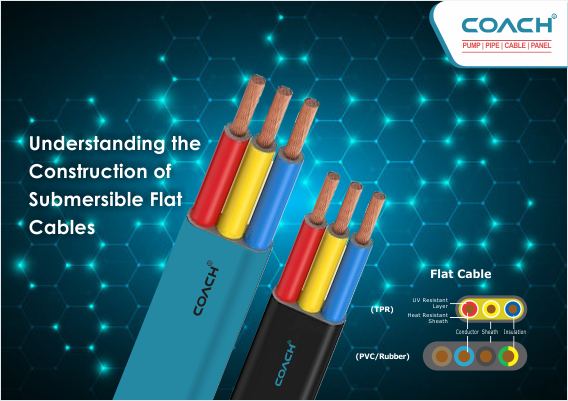Understanding the Construction of Submersible Flat Cables: Materials and Design Features
- May 22, 2023
- Category :Cables

Introduction:
Submersible flat cables are essential components of submersible pump systems, providing a safe and reliable electrical connection between the pump and the control panel. These cables are specifically designed to withstand the harsh conditions of underwater environments. In this blog post, we will delve into the construction of submersible flat cables, exploring the materials used and the design features that make them suitable for submersible applications.
- Insulation Material:
The insulation material used in submersible flat cables plays a crucial role in ensuring electrical safety and protection against water ingress. Commonly used insulation materials include PVC (Polyvinyl Chloride), XLPE (Cross-linked Polyethylene), and EPR (Ethylene Propylene Rubber). These materials offer excellent resistance to water, abrasion, and chemicals, providing insulation integrity even when submerged in water.
- Conductor Material:
The conductor carries the electrical current within the submersible flat cable. Copper is the most commonly used conductor material due to its excellent electrical conductivity and corrosion resistance. Copper conductors ensure efficient power transmission and minimize power loss. Aluminum conductors are also used in some applications where weight or cost considerations are important.
- Shielding:
Shielding is an important feature in submersible flat cables as it protects the cable from external interference and minimizes signal distortion. Shielding is achieved by adding a layer of metallic or non-metallic material around the conductor or by using a combination of both. Metallic shielding, such as aluminum or copper foil, provides effective protection against electromagnetic interference (EMI) and radio frequency interference (RFI).
- Jacket Material:
The outer jacket of submersible flat cables provides mechanical protection and resistance to environmental factors. It is typically made of PVC or a thermoplastic elastomer (TPE) material. The jacket material should be durable, flexible, and resistant to abrasion, sunlight, oil, and chemicals. It ensures the longevity and reliability of the cable, even in demanding submersible environments.
- Design Features:
Submersible flat cables are specifically designed to withstand the unique challenges of underwater applications. They often incorporate design features to enhance their performance and reliability. These features may include:
- Water-blocking technology: Special fillers or tapes are added within the cable to prevent water penetration and maintain electrical insulation integrity.
- Enhanced flexibility: Submersible flat cables are designed to be highly flexible to facilitate easy installation and maneuverability in tight spaces.
- Tightly stranded conductors: Stranding the conductors tightly enhances the cable’s flexibility and resistance to breakage.
- UV resistance: The outer jacket is often UV-resistant to protect the cable from damage caused by prolonged exposure to sunlight.
Conclusion:
Understanding the construction of submersible flat cables is essential for selecting the right cable for your submersible pump system. The choice of insulation material, conductor material, shielding, jacket material, and design features directly impact the cable’s performance and reliability in submersible environments. By using high-quality materials and incorporating robust design features, submersible flat cables ensure a safe and efficient electrical connection for submersible pump operations. When choosing submersible flat cables, always consider the specific requirements of your application to ensure long-term performance and protection in underwater environments.






